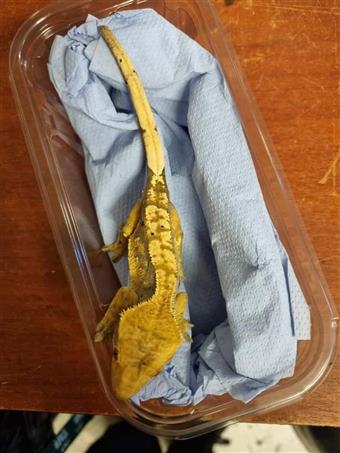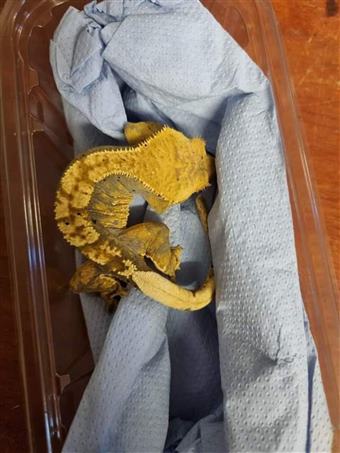Crested Gecko (Correlophus ciliatus)
This animal is currently unavailable. Please get in touch to register your interest.
The crested gecko has hair-like projections found above the eyes, resembling eyelashes. It has a wedge-shaped head and a crest that runs from each eye to the tail. Crested geckos do not have eyelids and so they use their long tongues to moisten their eyes and remove debris. The toes and the tip of the semi-prehensile tail are covered in small hairs called setae. Each seta is divided into hundreds of smaller (approximately 200 nanometres in diameter) hairs called spatulae. It is believed these structures exploit the weak van der Waals force to help the gecko climb on most solid surfaces. The toes have small claws which aid in climbing surfaces to which their toes cannot cling. They possess a semi-prehensile tail which they use to assist in climbing. The tail can be dropped as a deterrent to predators. Unlike some other geckos, once they lose their tail it will not grow back; however, this is not as harmful to the gecko as it is in other species, such as the Leopard gecko. In fact, most adults in the wild lack tails.
The crested gecko has many naturally occurring color groups, some of which include: grey, brown, red, orange, and yellow of various shades. They have variable markings, which include spots, straight stripes, and tiger-like stripes. The colors are brighter and more prominent at night.
The crested gecko has distinct structural morphs in head size and crest abundance. Geckos with a head length less than 1.3 times its width are considered "crowned". The numbers and sizes of crests can vary; some geckos have crests that extend to the base of the tail and some lack crests on one side of their body.
This animal was last updated in the past month. Please make sure to contact us before travelling long distances regarding this animal.
Any prices listed are subject to change, all final prices are decided in the shop.
 Coldwater, Tropical & Cichlids
Coldwater, Tropical & Cichlids
 Pythons, Boas & Colubrids
Pythons, Boas & Colubrids
 Agamas, Iguanas, Geckos & More!
Agamas, Iguanas, Geckos & More!
 Tortoises & Turtles
Tortoises & Turtles
 Frogs, Toads & Newts
Frogs, Toads & Newts
 Spiders
Spiders
 Hedgehogs, Mantids & More!
Hedgehogs, Mantids & More!
(Phelsuma grandis)
(Correlophus ciliatus)
(Correlophus ciliatus)
(Eublepharis macularius)
(Eublepharis macularius)
(Eublepharis macularius)

